ACC305 Audit and Professional Practice Assignment, XYZ University
VerifiedAdded on 2023/04/11
|10
|2508
|257
Report
AI Summary
This report provides a detailed analysis of various audit-related scenarios, classifying them into self-interest, self-review, familiarity, intimidation, and advocacy threats, and explaining the rationale behind each classification. It examines a specific case study to identify potential threats to compli...
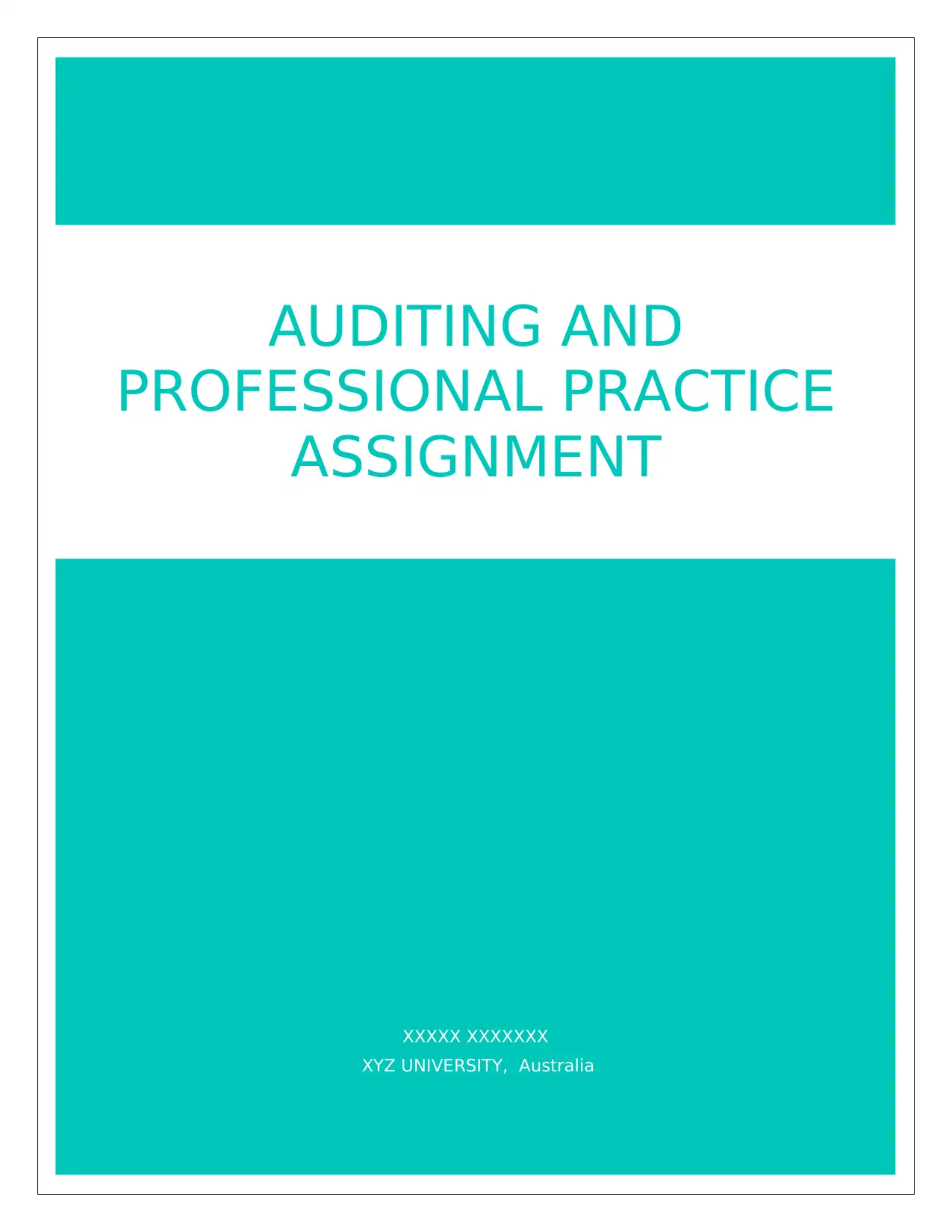
XXXXX XXXXXXX
XYZ UNIVERSITY, Australia
AUDITING AND
PROFESSIONAL PRACTICE
ASSIGNMENT
XYZ UNIVERSITY, Australia
AUDITING AND
PROFESSIONAL PRACTICE
ASSIGNMENT
Paraphrase This Document
Need a fresh take? Get an instant paraphrase of this document with our AI Paraphraser
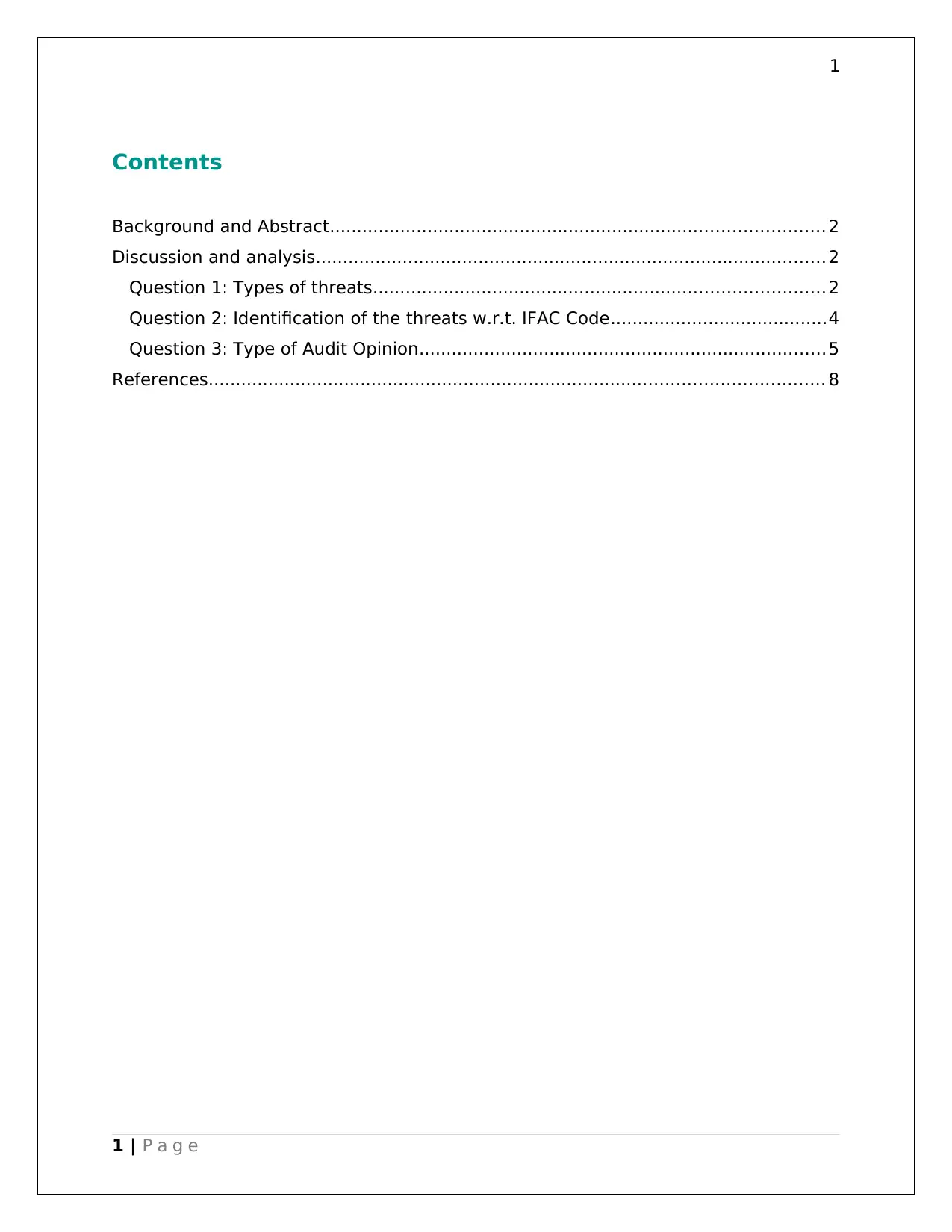
1
Contents
Background and Abstract........................................................................................... 2
Discussion and analysis.............................................................................................. 2
Question 1: Types of threats................................................................................... 2
Question 2: Identification of the threats w.r.t. IFAC Code........................................4
Question 3: Type of Audit Opinion...........................................................................5
References................................................................................................................. 8
1 | P a g e
Contents
Background and Abstract........................................................................................... 2
Discussion and analysis.............................................................................................. 2
Question 1: Types of threats................................................................................... 2
Question 2: Identification of the threats w.r.t. IFAC Code........................................4
Question 3: Type of Audit Opinion...........................................................................5
References................................................................................................................. 8
1 | P a g e

2
Background and Abstract
The report classifies and segregates the different mentioned scenarios into self-interest, self-
review, familiarity, intimidation and advocacy threats along with the corresponding reasons.
These threats hinder the independence of the auditors. In part 2 of the assignment, the given
scenario has been studied so as to highlight any threat to the compliance of IFAC code (Arnott,
et al., 2017). In the third section of the report, several case studies have been given based on
which the type of audit opinion that should be given has been stated along with the reasons.
Discussion and analysis
Question 1: Types of threats
1. The CEO threatens to change auditors unless an unqualified opinion is issued: This is a
clear case of intimidation threat where the auditor is being prevented from acting
objectively and use professional scepticism by the actual threating from the CEO of the
company.
2. Each member of the audit team received a holiday cruise as a gift from the client: This
poses a self-interest threat on the auditors as the conflict of interest may arise when the
auditors are doing their work and thus it may also influence their behaviour and
judgement at work (Belton, 2017).
3. The audit partner owns a significant amount of shares in the client company: This is a
scenario of advocacy threat to the audit partner as he would be inclined towards good
results of the client company since he is holding shares in the client company. Thus, he
may be forced to promote the position of client company.
4. The audit partner is the brother-in-law of the client company’s director: This is a case of
familiarity threat as the audit partner may become sympathetic towards the interest of
Client Company’s director in view of the close relationship which in turn may result into
professional misjudgement (Alexander, 2016).
5. The audit firm is promoting a new issue of shares from the client company: This is a case
of advocacy threat as the audit firm is again inclined towards the success of the issue of
2 | P a g e
Background and Abstract
The report classifies and segregates the different mentioned scenarios into self-interest, self-
review, familiarity, intimidation and advocacy threats along with the corresponding reasons.
These threats hinder the independence of the auditors. In part 2 of the assignment, the given
scenario has been studied so as to highlight any threat to the compliance of IFAC code (Arnott,
et al., 2017). In the third section of the report, several case studies have been given based on
which the type of audit opinion that should be given has been stated along with the reasons.
Discussion and analysis
Question 1: Types of threats
1. The CEO threatens to change auditors unless an unqualified opinion is issued: This is a
clear case of intimidation threat where the auditor is being prevented from acting
objectively and use professional scepticism by the actual threating from the CEO of the
company.
2. Each member of the audit team received a holiday cruise as a gift from the client: This
poses a self-interest threat on the auditors as the conflict of interest may arise when the
auditors are doing their work and thus it may also influence their behaviour and
judgement at work (Belton, 2017).
3. The audit partner owns a significant amount of shares in the client company: This is a
scenario of advocacy threat to the audit partner as he would be inclined towards good
results of the client company since he is holding shares in the client company. Thus, he
may be forced to promote the position of client company.
4. The audit partner is the brother-in-law of the client company’s director: This is a case of
familiarity threat as the audit partner may become sympathetic towards the interest of
Client Company’s director in view of the close relationship which in turn may result into
professional misjudgement (Alexander, 2016).
5. The audit firm is promoting a new issue of shares from the client company: This is a case
of advocacy threat as the audit firm is again inclined towards the success of the issue of
2 | P a g e
⊘ This is a preview!⊘
Do you want full access?
Subscribe today to unlock all pages.

Trusted by 1+ million students worldwide
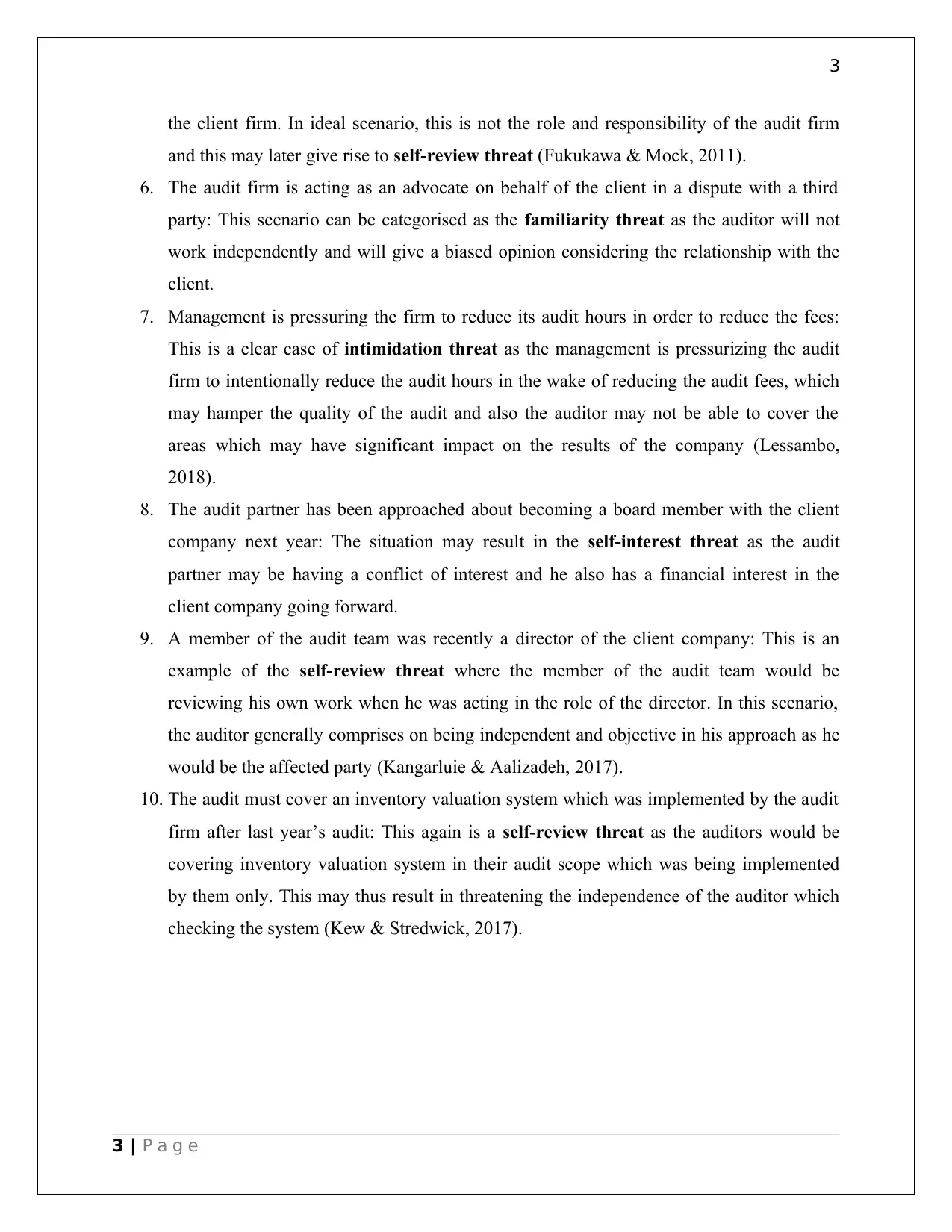
3
the client firm. In ideal scenario, this is not the role and responsibility of the audit firm
and this may later give rise to self-review threat (Fukukawa & Mock, 2011).
6. The audit firm is acting as an advocate on behalf of the client in a dispute with a third
party: This scenario can be categorised as the familiarity threat as the auditor will not
work independently and will give a biased opinion considering the relationship with the
client.
7. Management is pressuring the firm to reduce its audit hours in order to reduce the fees:
This is a clear case of intimidation threat as the management is pressurizing the audit
firm to intentionally reduce the audit hours in the wake of reducing the audit fees, which
may hamper the quality of the audit and also the auditor may not be able to cover the
areas which may have significant impact on the results of the company (Lessambo,
2018).
8. The audit partner has been approached about becoming a board member with the client
company next year: The situation may result in the self-interest threat as the audit
partner may be having a conflict of interest and he also has a financial interest in the
client company going forward.
9. A member of the audit team was recently a director of the client company: This is an
example of the self-review threat where the member of the audit team would be
reviewing his own work when he was acting in the role of the director. In this scenario,
the auditor generally comprises on being independent and objective in his approach as he
would be the affected party (Kangarluie & Aalizadeh, 2017).
10. The audit must cover an inventory valuation system which was implemented by the audit
firm after last year’s audit: This again is a self-review threat as the auditors would be
covering inventory valuation system in their audit scope which was being implemented
by them only. This may thus result in threatening the independence of the auditor which
checking the system (Kew & Stredwick, 2017).
3 | P a g e
the client firm. In ideal scenario, this is not the role and responsibility of the audit firm
and this may later give rise to self-review threat (Fukukawa & Mock, 2011).
6. The audit firm is acting as an advocate on behalf of the client in a dispute with a third
party: This scenario can be categorised as the familiarity threat as the auditor will not
work independently and will give a biased opinion considering the relationship with the
client.
7. Management is pressuring the firm to reduce its audit hours in order to reduce the fees:
This is a clear case of intimidation threat as the management is pressurizing the audit
firm to intentionally reduce the audit hours in the wake of reducing the audit fees, which
may hamper the quality of the audit and also the auditor may not be able to cover the
areas which may have significant impact on the results of the company (Lessambo,
2018).
8. The audit partner has been approached about becoming a board member with the client
company next year: The situation may result in the self-interest threat as the audit
partner may be having a conflict of interest and he also has a financial interest in the
client company going forward.
9. A member of the audit team was recently a director of the client company: This is an
example of the self-review threat where the member of the audit team would be
reviewing his own work when he was acting in the role of the director. In this scenario,
the auditor generally comprises on being independent and objective in his approach as he
would be the affected party (Kangarluie & Aalizadeh, 2017).
10. The audit must cover an inventory valuation system which was implemented by the audit
firm after last year’s audit: This again is a self-review threat as the auditors would be
covering inventory valuation system in their audit scope which was being implemented
by them only. This may thus result in threatening the independence of the auditor which
checking the system (Kew & Stredwick, 2017).
3 | P a g e
Paraphrase This Document
Need a fresh take? Get an instant paraphrase of this document with our AI Paraphraser
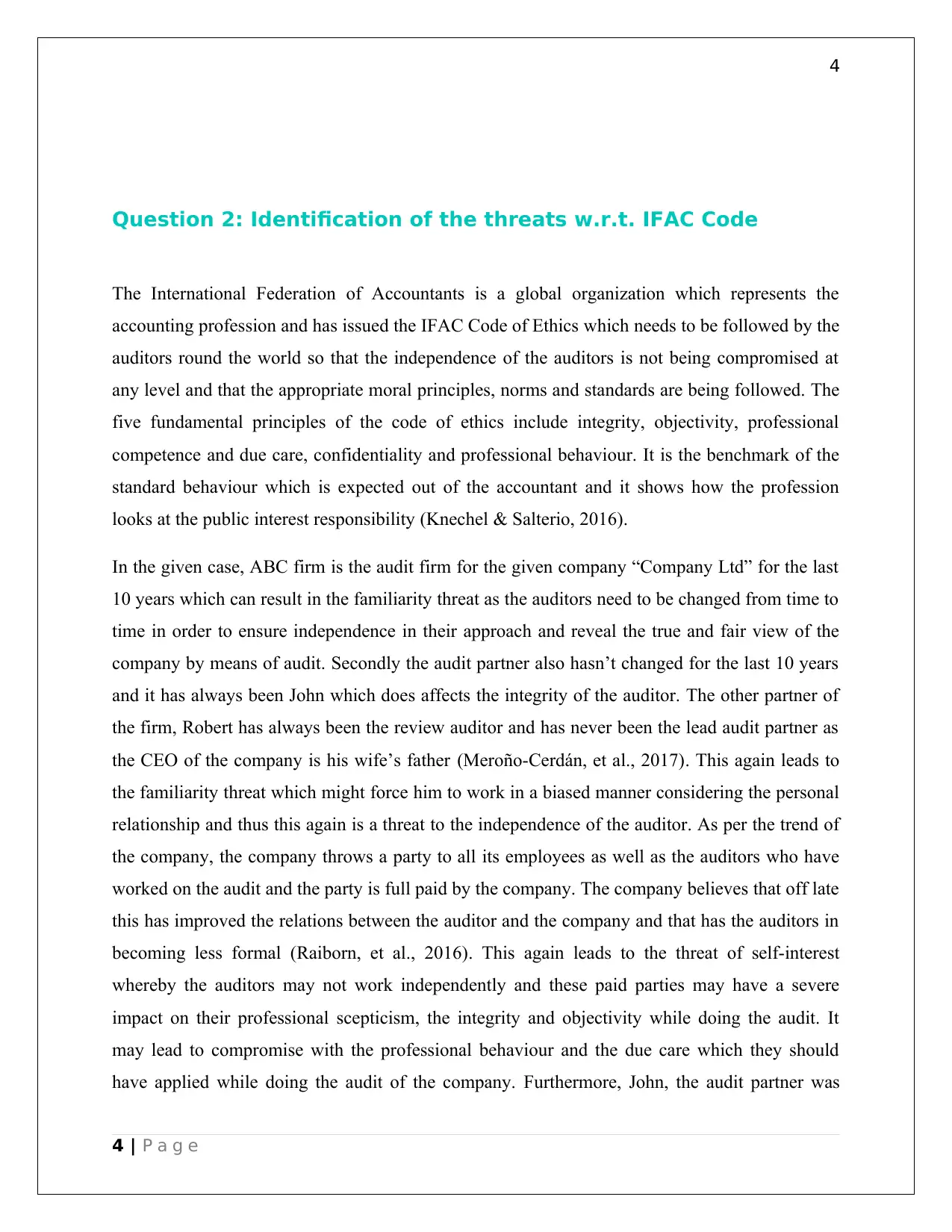
4
Question 2: Identification of the threats w.r.t. IFAC Code
The International Federation of Accountants is a global organization which represents the
accounting profession and has issued the IFAC Code of Ethics which needs to be followed by the
auditors round the world so that the independence of the auditors is not being compromised at
any level and that the appropriate moral principles, norms and standards are being followed. The
five fundamental principles of the code of ethics include integrity, objectivity, professional
competence and due care, confidentiality and professional behaviour. It is the benchmark of the
standard behaviour which is expected out of the accountant and it shows how the profession
looks at the public interest responsibility (Knechel & Salterio, 2016).
In the given case, ABC firm is the audit firm for the given company “Company Ltd” for the last
10 years which can result in the familiarity threat as the auditors need to be changed from time to
time in order to ensure independence in their approach and reveal the true and fair view of the
company by means of audit. Secondly the audit partner also hasn’t changed for the last 10 years
and it has always been John which does affects the integrity of the auditor. The other partner of
the firm, Robert has always been the review auditor and has never been the lead audit partner as
the CEO of the company is his wife’s father (Meroño-Cerdán, et al., 2017). This again leads to
the familiarity threat which might force him to work in a biased manner considering the personal
relationship and thus this again is a threat to the independence of the auditor. As per the trend of
the company, the company throws a party to all its employees as well as the auditors who have
worked on the audit and the party is full paid by the company. The company believes that off late
this has improved the relations between the auditor and the company and that has the auditors in
becoming less formal (Raiborn, et al., 2016). This again leads to the threat of self-interest
whereby the auditors may not work independently and these paid parties may have a severe
impact on their professional scepticism, the integrity and objectivity while doing the audit. It
may lead to compromise with the professional behaviour and the due care which they should
have applied while doing the audit of the company. Furthermore, John, the audit partner was
4 | P a g e
Question 2: Identification of the threats w.r.t. IFAC Code
The International Federation of Accountants is a global organization which represents the
accounting profession and has issued the IFAC Code of Ethics which needs to be followed by the
auditors round the world so that the independence of the auditors is not being compromised at
any level and that the appropriate moral principles, norms and standards are being followed. The
five fundamental principles of the code of ethics include integrity, objectivity, professional
competence and due care, confidentiality and professional behaviour. It is the benchmark of the
standard behaviour which is expected out of the accountant and it shows how the profession
looks at the public interest responsibility (Knechel & Salterio, 2016).
In the given case, ABC firm is the audit firm for the given company “Company Ltd” for the last
10 years which can result in the familiarity threat as the auditors need to be changed from time to
time in order to ensure independence in their approach and reveal the true and fair view of the
company by means of audit. Secondly the audit partner also hasn’t changed for the last 10 years
and it has always been John which does affects the integrity of the auditor. The other partner of
the firm, Robert has always been the review auditor and has never been the lead audit partner as
the CEO of the company is his wife’s father (Meroño-Cerdán, et al., 2017). This again leads to
the familiarity threat which might force him to work in a biased manner considering the personal
relationship and thus this again is a threat to the independence of the auditor. As per the trend of
the company, the company throws a party to all its employees as well as the auditors who have
worked on the audit and the party is full paid by the company. The company believes that off late
this has improved the relations between the auditor and the company and that has the auditors in
becoming less formal (Raiborn, et al., 2016). This again leads to the threat of self-interest
whereby the auditors may not work independently and these paid parties may have a severe
impact on their professional scepticism, the integrity and objectivity while doing the audit. It
may lead to compromise with the professional behaviour and the due care which they should
have applied while doing the audit of the company. Furthermore, John, the audit partner was
4 | P a g e

5
being approached recently by the company for offer of employment as the director of the
company for the starting term of 2 years with the condition of lowering the audit fees for current
and next year. This is a clear case of advocacy threat on the audit partner who may compromise
with the independence in order to become director of the company. Later on this will also take
the shape of self-review threat. Thus, all in all, the given case clearly compromises with many
aspects and principles laid down in IFAC Code of Ethics and threats like advocacy threat,
familiarity threat and self-interest threat are quite evident on the face of it and the same will lead
to threaten the independence of the auditors as well.
Question 3: Type of Audit Opinion
a. The auditor was unable to obtain confirmations from eight of the client’s major
customers that were included in the sample however the auditor was able to satisfy
himself about the balances of these accounts using other audit procedures.
In the given case, the auditor was able to satisfy himself w.r.t. the balances of the
accounts and hence there was no anomaly and therefore there is no indication of material
misstatement of the financial statements. Thus, the auditor should give unqualified
opinion in the given case (Goldmann, 2016).
b. The client restricted the auditor from carrying out procedures to verify the
property, plant and equipment .The property, plant and equipment comprises 35%
of total assets.
In the given case, property, plant and equipment constitutes almost one-third of the total
assets and thus forms a significant portion of the assets side of balance sheet. Since the
client is restricting from carrying out procedures to check on the same, it might result into
material misstatement if the assets are misstated in the books. Therefore in this case, the
auditor should give disclaimer opinion as there is insufficient support from the
management (Sonu, et al., 2017).
c. Management have excluded from the financial report the necessary disclosures in
relation to a contingent liability. If this becomes an actual liability it will have a
material effect on the financial report when it becomes an actual liability.
In the given case, the management of the company has missed one of the critical
disclosures in the financial report on the contingent liability which may have a material
5 | P a g e
being approached recently by the company for offer of employment as the director of the
company for the starting term of 2 years with the condition of lowering the audit fees for current
and next year. This is a clear case of advocacy threat on the audit partner who may compromise
with the independence in order to become director of the company. Later on this will also take
the shape of self-review threat. Thus, all in all, the given case clearly compromises with many
aspects and principles laid down in IFAC Code of Ethics and threats like advocacy threat,
familiarity threat and self-interest threat are quite evident on the face of it and the same will lead
to threaten the independence of the auditors as well.
Question 3: Type of Audit Opinion
a. The auditor was unable to obtain confirmations from eight of the client’s major
customers that were included in the sample however the auditor was able to satisfy
himself about the balances of these accounts using other audit procedures.
In the given case, the auditor was able to satisfy himself w.r.t. the balances of the
accounts and hence there was no anomaly and therefore there is no indication of material
misstatement of the financial statements. Thus, the auditor should give unqualified
opinion in the given case (Goldmann, 2016).
b. The client restricted the auditor from carrying out procedures to verify the
property, plant and equipment .The property, plant and equipment comprises 35%
of total assets.
In the given case, property, plant and equipment constitutes almost one-third of the total
assets and thus forms a significant portion of the assets side of balance sheet. Since the
client is restricting from carrying out procedures to check on the same, it might result into
material misstatement if the assets are misstated in the books. Therefore in this case, the
auditor should give disclaimer opinion as there is insufficient support from the
management (Sonu, et al., 2017).
c. Management have excluded from the financial report the necessary disclosures in
relation to a contingent liability. If this becomes an actual liability it will have a
material effect on the financial report when it becomes an actual liability.
In the given case, the management of the company has missed one of the critical
disclosures in the financial report on the contingent liability which may have a material
5 | P a g e
⊘ This is a preview!⊘
Do you want full access?
Subscribe today to unlock all pages.

Trusted by 1+ million students worldwide
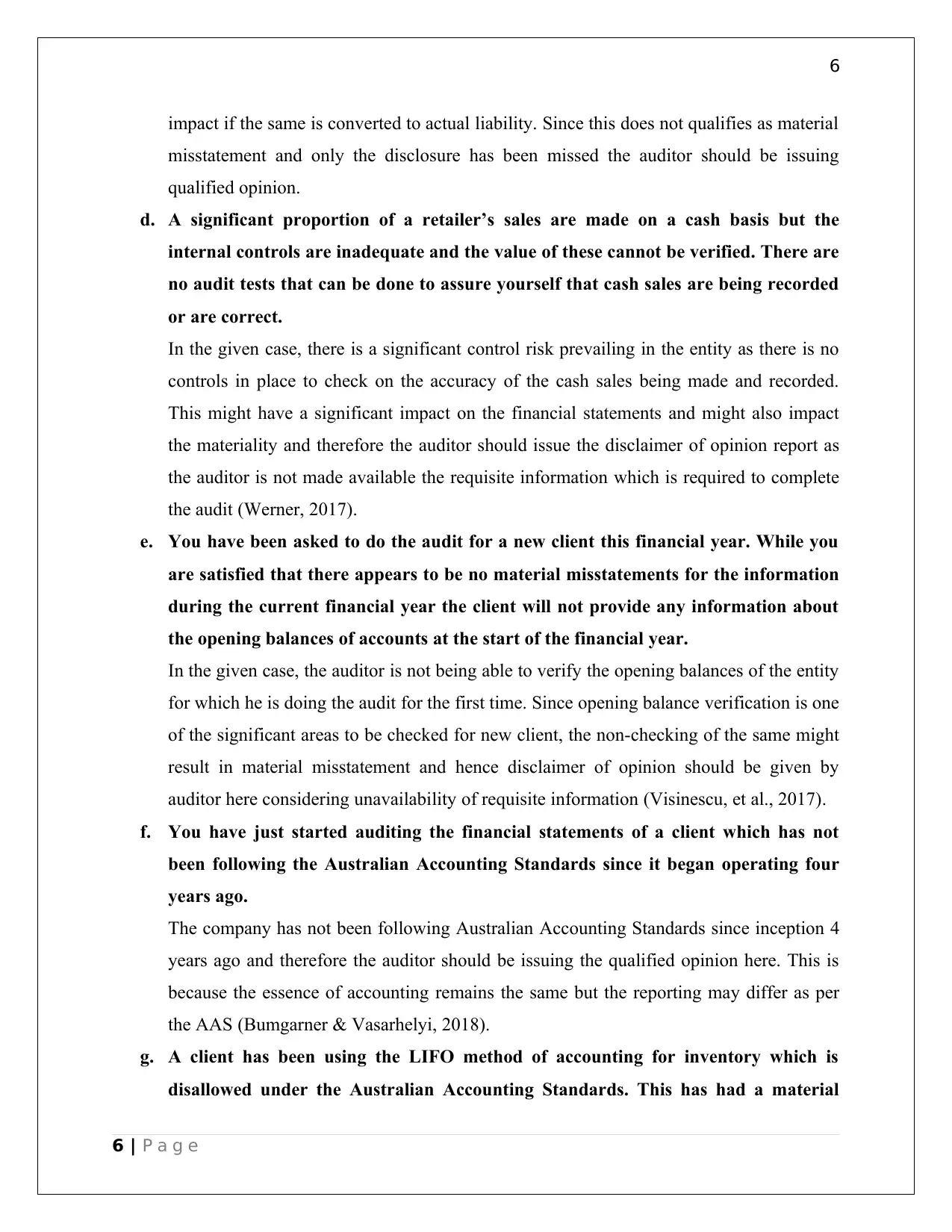
6
impact if the same is converted to actual liability. Since this does not qualifies as material
misstatement and only the disclosure has been missed the auditor should be issuing
qualified opinion.
d. A significant proportion of a retailer’s sales are made on a cash basis but the
internal controls are inadequate and the value of these cannot be verified. There are
no audit tests that can be done to assure yourself that cash sales are being recorded
or are correct.
In the given case, there is a significant control risk prevailing in the entity as there is no
controls in place to check on the accuracy of the cash sales being made and recorded.
This might have a significant impact on the financial statements and might also impact
the materiality and therefore the auditor should issue the disclaimer of opinion report as
the auditor is not made available the requisite information which is required to complete
the audit (Werner, 2017).
e. You have been asked to do the audit for a new client this financial year. While you
are satisfied that there appears to be no material misstatements for the information
during the current financial year the client will not provide any information about
the opening balances of accounts at the start of the financial year.
In the given case, the auditor is not being able to verify the opening balances of the entity
for which he is doing the audit for the first time. Since opening balance verification is one
of the significant areas to be checked for new client, the non-checking of the same might
result in material misstatement and hence disclaimer of opinion should be given by
auditor here considering unavailability of requisite information (Visinescu, et al., 2017).
f. You have just started auditing the financial statements of a client which has not
been following the Australian Accounting Standards since it began operating four
years ago.
The company has not been following Australian Accounting Standards since inception 4
years ago and therefore the auditor should be issuing the qualified opinion here. This is
because the essence of accounting remains the same but the reporting may differ as per
the AAS (Bumgarner & Vasarhelyi, 2018).
g. A client has been using the LIFO method of accounting for inventory which is
disallowed under the Australian Accounting Standards. This has had a material
6 | P a g e
impact if the same is converted to actual liability. Since this does not qualifies as material
misstatement and only the disclosure has been missed the auditor should be issuing
qualified opinion.
d. A significant proportion of a retailer’s sales are made on a cash basis but the
internal controls are inadequate and the value of these cannot be verified. There are
no audit tests that can be done to assure yourself that cash sales are being recorded
or are correct.
In the given case, there is a significant control risk prevailing in the entity as there is no
controls in place to check on the accuracy of the cash sales being made and recorded.
This might have a significant impact on the financial statements and might also impact
the materiality and therefore the auditor should issue the disclaimer of opinion report as
the auditor is not made available the requisite information which is required to complete
the audit (Werner, 2017).
e. You have been asked to do the audit for a new client this financial year. While you
are satisfied that there appears to be no material misstatements for the information
during the current financial year the client will not provide any information about
the opening balances of accounts at the start of the financial year.
In the given case, the auditor is not being able to verify the opening balances of the entity
for which he is doing the audit for the first time. Since opening balance verification is one
of the significant areas to be checked for new client, the non-checking of the same might
result in material misstatement and hence disclaimer of opinion should be given by
auditor here considering unavailability of requisite information (Visinescu, et al., 2017).
f. You have just started auditing the financial statements of a client which has not
been following the Australian Accounting Standards since it began operating four
years ago.
The company has not been following Australian Accounting Standards since inception 4
years ago and therefore the auditor should be issuing the qualified opinion here. This is
because the essence of accounting remains the same but the reporting may differ as per
the AAS (Bumgarner & Vasarhelyi, 2018).
g. A client has been using the LIFO method of accounting for inventory which is
disallowed under the Australian Accounting Standards. This has had a material
6 | P a g e
Paraphrase This Document
Need a fresh take? Get an instant paraphrase of this document with our AI Paraphraser
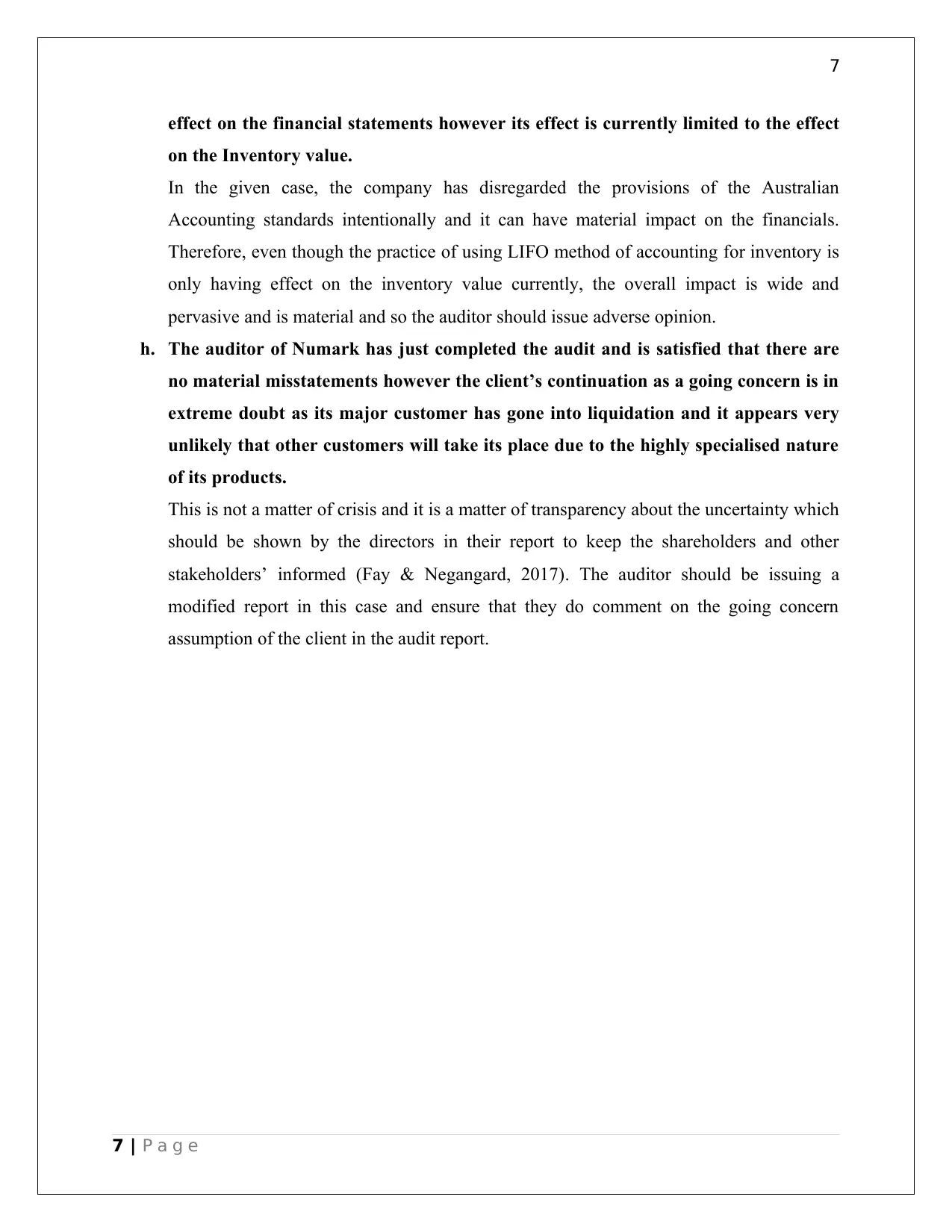
7
effect on the financial statements however its effect is currently limited to the effect
on the Inventory value.
In the given case, the company has disregarded the provisions of the Australian
Accounting standards intentionally and it can have material impact on the financials.
Therefore, even though the practice of using LIFO method of accounting for inventory is
only having effect on the inventory value currently, the overall impact is wide and
pervasive and is material and so the auditor should issue adverse opinion.
h. The auditor of Numark has just completed the audit and is satisfied that there are
no material misstatements however the client’s continuation as a going concern is in
extreme doubt as its major customer has gone into liquidation and it appears very
unlikely that other customers will take its place due to the highly specialised nature
of its products.
This is not a matter of crisis and it is a matter of transparency about the uncertainty which
should be shown by the directors in their report to keep the shareholders and other
stakeholders’ informed (Fay & Negangard, 2017). The auditor should be issuing a
modified report in this case and ensure that they do comment on the going concern
assumption of the client in the audit report.
7 | P a g e
effect on the financial statements however its effect is currently limited to the effect
on the Inventory value.
In the given case, the company has disregarded the provisions of the Australian
Accounting standards intentionally and it can have material impact on the financials.
Therefore, even though the practice of using LIFO method of accounting for inventory is
only having effect on the inventory value currently, the overall impact is wide and
pervasive and is material and so the auditor should issue adverse opinion.
h. The auditor of Numark has just completed the audit and is satisfied that there are
no material misstatements however the client’s continuation as a going concern is in
extreme doubt as its major customer has gone into liquidation and it appears very
unlikely that other customers will take its place due to the highly specialised nature
of its products.
This is not a matter of crisis and it is a matter of transparency about the uncertainty which
should be shown by the directors in their report to keep the shareholders and other
stakeholders’ informed (Fay & Negangard, 2017). The auditor should be issuing a
modified report in this case and ensure that they do comment on the going concern
assumption of the client in the audit report.
7 | P a g e
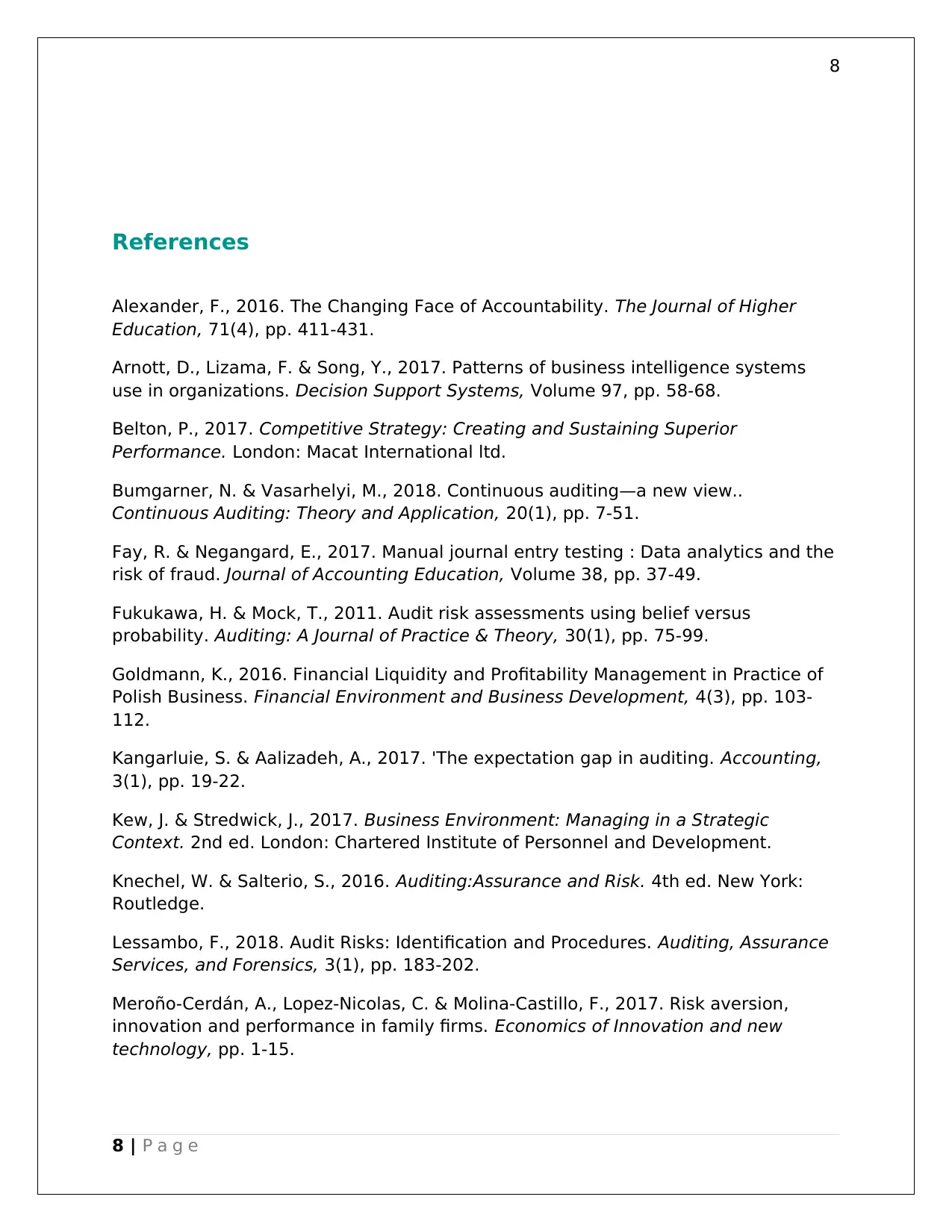
8
References
Alexander, F., 2016. The Changing Face of Accountability. The Journal of Higher
Education, 71(4), pp. 411-431.
Arnott, D., Lizama, F. & Song, Y., 2017. Patterns of business intelligence systems
use in organizations. Decision Support Systems, Volume 97, pp. 58-68.
Belton, P., 2017. Competitive Strategy: Creating and Sustaining Superior
Performance. London: Macat International ltd.
Bumgarner, N. & Vasarhelyi, M., 2018. Continuous auditing—a new view..
Continuous Auditing: Theory and Application, 20(1), pp. 7-51.
Fay, R. & Negangard, E., 2017. Manual journal entry testing : Data analytics and the
risk of fraud. Journal of Accounting Education, Volume 38, pp. 37-49.
Fukukawa, H. & Mock, T., 2011. Audit risk assessments using belief versus
probability. Auditing: A Journal of Practice & Theory, 30(1), pp. 75-99.
Goldmann, K., 2016. Financial Liquidity and Profitability Management in Practice of
Polish Business. Financial Environment and Business Development, 4(3), pp. 103-
112.
Kangarluie, S. & Aalizadeh, A., 2017. 'The expectation gap in auditing. Accounting,
3(1), pp. 19-22.
Kew, J. & Stredwick, J., 2017. Business Environment: Managing in a Strategic
Context. 2nd ed. London: Chartered Institute of Personnel and Development.
Knechel, W. & Salterio, S., 2016. Auditing:Assurance and Risk. 4th ed. New York:
Routledge.
Lessambo, F., 2018. Audit Risks: Identification and Procedures. Auditing, Assurance
Services, and Forensics, 3(1), pp. 183-202.
Meroño-Cerdán, A., Lopez-Nicolas, C. & Molina-Castillo, F., 2017. Risk aversion,
innovation and performance in family firms. Economics of Innovation and new
technology, pp. 1-15.
8 | P a g e
References
Alexander, F., 2016. The Changing Face of Accountability. The Journal of Higher
Education, 71(4), pp. 411-431.
Arnott, D., Lizama, F. & Song, Y., 2017. Patterns of business intelligence systems
use in organizations. Decision Support Systems, Volume 97, pp. 58-68.
Belton, P., 2017. Competitive Strategy: Creating and Sustaining Superior
Performance. London: Macat International ltd.
Bumgarner, N. & Vasarhelyi, M., 2018. Continuous auditing—a new view..
Continuous Auditing: Theory and Application, 20(1), pp. 7-51.
Fay, R. & Negangard, E., 2017. Manual journal entry testing : Data analytics and the
risk of fraud. Journal of Accounting Education, Volume 38, pp. 37-49.
Fukukawa, H. & Mock, T., 2011. Audit risk assessments using belief versus
probability. Auditing: A Journal of Practice & Theory, 30(1), pp. 75-99.
Goldmann, K., 2016. Financial Liquidity and Profitability Management in Practice of
Polish Business. Financial Environment and Business Development, 4(3), pp. 103-
112.
Kangarluie, S. & Aalizadeh, A., 2017. 'The expectation gap in auditing. Accounting,
3(1), pp. 19-22.
Kew, J. & Stredwick, J., 2017. Business Environment: Managing in a Strategic
Context. 2nd ed. London: Chartered Institute of Personnel and Development.
Knechel, W. & Salterio, S., 2016. Auditing:Assurance and Risk. 4th ed. New York:
Routledge.
Lessambo, F., 2018. Audit Risks: Identification and Procedures. Auditing, Assurance
Services, and Forensics, 3(1), pp. 183-202.
Meroño-Cerdán, A., Lopez-Nicolas, C. & Molina-Castillo, F., 2017. Risk aversion,
innovation and performance in family firms. Economics of Innovation and new
technology, pp. 1-15.
8 | P a g e
⊘ This is a preview!⊘
Do you want full access?
Subscribe today to unlock all pages.

Trusted by 1+ million students worldwide

9
Raiborn, C., Butler, J. & Martin, K., 2016. The internal audit function: A prerequisite
for Good Governance. Journal of Corporate Accounting and Finance, 28(2), pp. 10-
21.
Sonu, C., Ahn, H. & Choi, A., 2017. Audit fee pressure and audit risk: evidence from
the financial crisis of 2008. Asia-Pacific Journal of Accounting & Economics , 24(1-2),
pp. 127-144.
Visinescu, L., Jones, M. & Sidorova, A., 2017. Improving Decision Quality: The Role of
Business Intelligence. Journal of Computer Information Systems, 57(1), pp. 58-66.
Werner, M., 2017. Financial process mining - Accounting data structure dependent
control flow inference. International Journal of Accounting Information Systems,
25(1), pp. 57-80.
9 | P a g e
Raiborn, C., Butler, J. & Martin, K., 2016. The internal audit function: A prerequisite
for Good Governance. Journal of Corporate Accounting and Finance, 28(2), pp. 10-
21.
Sonu, C., Ahn, H. & Choi, A., 2017. Audit fee pressure and audit risk: evidence from
the financial crisis of 2008. Asia-Pacific Journal of Accounting & Economics , 24(1-2),
pp. 127-144.
Visinescu, L., Jones, M. & Sidorova, A., 2017. Improving Decision Quality: The Role of
Business Intelligence. Journal of Computer Information Systems, 57(1), pp. 58-66.
Werner, M., 2017. Financial process mining - Accounting data structure dependent
control flow inference. International Journal of Accounting Information Systems,
25(1), pp. 57-80.
9 | P a g e
1 out of 10
Related Documents
Your All-in-One AI-Powered Toolkit for Academic Success.
+13062052269
info@desklib.com
Available 24*7 on WhatsApp / Email
![[object Object]](/_next/static/media/star-bottom.7253800d.svg)
Unlock your academic potential
© 2024 | Zucol Services PVT LTD | All rights reserved.




